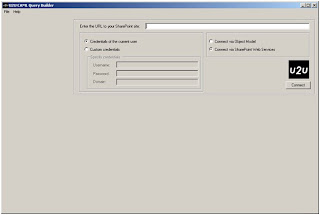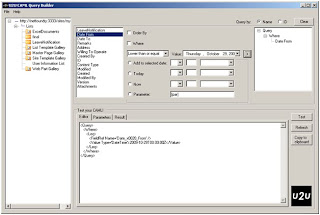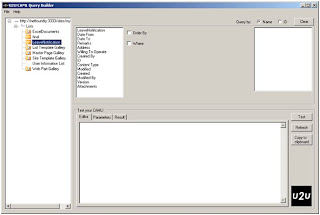Thursday, October 29, 2009
Creating a SharePoint page using Object Model
{
SPWeb web = SPContext.Current.Web.Site.RootWeb;
//SPContext.Current.Web;
using (web)
{
web.AllowUnsafeUpdates = true;
SPList list = web.Lists["Pages"]
String url = list.RootFolder.ServerRelativeUrl.ToString();
// if you want to add the new page in a existing folder you can take it by it's ID like below
//SPListItem newFolder = list.Folders.GetItemById(3);
// creating a publishing web
PublishingWeb publishingWeb = PublishingWeb.GetPublishingWeb(web)
PageLayout[] layouts = publishingWeb.GetAvailablePageLayouts();
PageLayout layout = null;
foreach (PageLayout _layout in layouts)
{
//set the page layout to your site's default layout
if (_layout.Name == "yourpagelayout.aspx")
{
layout = _layout;
break;
}
}
PublishingPage newPage = publishingWeb.GetPublishingPages().Add("sample.aspx", layout);
// setting the URL value to the newPageUrl for redirecting the user after creating it
//newPageUrl = web.Url + "/" + newPage.Url;
newPage.Description = "Sample page from code behind Dynamic Page";
newPage.Title = "Dynamic Page";
newPage.Update();
//Now we can checkin the newly created page to the “pages” library
SPFile pageFile = newPage.ListItem.File;
if (pageFile.CheckOutStatus != SPFile.SPCheckOutStatus.None)
{
pageFile.CheckIn("CheckedIn");
pageFile.Publish("publihsed");
}
}
});
Querying a SharePoint list using CAML (Collaborative Application Markup Language) builder and updating a List using SharePoint Object model.
Extract the zip file from above download and
click on U2UCamlCreator.exe which opens the below screen

 Now select the desired list on which you want to perform a query. In this case I am selecting a list existing on my site leavenotification and then CAML builder shows all the columns of the list as shown below.
Now select the desired list on which you want to perform a query. In this case I am selecting a list existing on my site leavenotification and then CAML builder shows all the columns of the list as shown below.
Now select the columns which you require for your application and you can set the where condition to build the query with an option of order by. In my case I am selecting Date From column with a where condition as date lower than or equal as shown below

To test this query click on Test button and the result will be displayed on a grid as shown below At any point of the time you can change the query by clicking Clear button on top right corner
Using SharePoint object model to query a list with the query generated from CAML builder.
Import Microsoft.sharepoint.dll
Code Part:
Try
{
SPWeb objSPWeb = SPContext.Current.Web.Site.RootWeb;
objSPWeb.AllowUnsafeUpdates = true;
SPList objSPList = objSPWeb.Lists["LeaveNotification"];
SPQuery queryErrData = new SPQuery();
string QueryOrderBy = "
SPListItemCollection objlistItemsErrLog = objSPList.GetItems(queryErrData);
}
catch
{
throw ;
}
From the above ListItemCollection we can access the result set by looping thru the collection using foreach
Wednesday, July 22, 2009
Saturday, July 18, 2009
Creating a basic sharepoint webpart
Step1. create a visual studio class library project and name it as BasicWebpart as shown below
 Step2: rename class1.cs in solution explorer to myWebPart.cs
Step2: rename class1.cs in solution explorer to myWebPart.cs
Step3: Add following references microsoft.sharepoint.dll (which will be available at "C:\Program Files\Common Files\Microsoft Shared\web server extensions\12\ISAPI") and system.web.dll by clicking reference tab in solution explorer. Import two dll's in the class file by "using" like below
using Microsoft.SharePoint;
using System.Web;
step4: inherit webpart class of "Microsoft.SharePoint.dll" with class file as shwon below
public class myWebPart : Microsoft.SharePoint.WebPartPages.WebPart
step5: override render method which is inherited from System.Web.UI.Control to put render some sample text. sample method to render the text
protected override void Render(System.Web.UI.HmlTextWriter writer)
{
writer.Write("This is my First basic Web Part");
}
final myWebPart.cs class file code will be as shown below
using System;
using System.Collections.Generic;
using System.Text;
using Microsoft.SharePoint;
using System.Web;
namespace basicWebpart
{
public class myWebPart : Microsoft.SharePoint.WebPartPages.WebPart
{
protected override void Render(System.Web.UI.HtmlTextWriter writer)
{
writer.Write("this is my first basic webpart");
}
}
}
step6: compile the project with successful compilation.
step7: Open web.config file of sitecollection where you want to add the webpart which will be located at "OS drive
and under SafeControls
<SafeControl Assembly=basicWebpart,Culture=neutral" Namespace="basicWebpart" TypeName="*" Safe="True" />
step8: copy the dll which will be resulted from step 6 to bin directory of the sitecollection.
OS Drive\Inetpub\wwwroot\wss\VirtualDirectories\bin"
with the steps 7 and 8 we completed adding our new webpart to site collection.
to add the new webpart open the desired sitecollection and goto site settings and in site setting page select webpart which will be under gallaries section. and click on new
now select the check box corresponding to your webpart and click populate gallery button.

now goto your desired page where you want to add the webpart and click on edit page and click on ADD WEBPART bar
and add your webart
What is the TRL library
⚡ What is the TRL library trl stands for Transformers Reinforcement Learning . It is an open-source library by Hugging Face that lets ...
-
Power BI allows you to effectively organize and analyze data by creating groups, bands, and hierarchies using conditional values. These fe...
-
Ranking data in Power BI provides valuable insights into performance and comparison. The RANKX function, combined with the ALL function,...
-
In Power BI, applying multiple filters to measures is a critical skill for building advanced, context-aware calculations. By using DAX funct...

